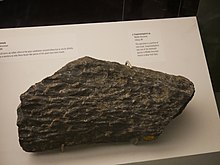Wattieza
| Wattieza Temporal range: Middle Devonian
| |
|---|---|

| |
| W. givetiana | |
| Scientific classification | |
| Kingdom: | |
| Division: | Pteridophyta |
| Class: | |
| Order: | |
| Genus: | Wattieza |
| Species | |
| |

Wattieza was a
Wattieza had
Belgian paleobotanist
English geologist and palaeobotanist Chris Berry described Wattieza casasii in Review of Paleobotany and Palynology (112) in 2000, based on fossil branches (13 slabs) and numerous other fragments (Berry, 2000) collected from middle Givetian-strata from the lower member of Campo Chico Formation (Casas et al, 2022). The lithology of the lower member consists in dark grey to green mudstones and shales, interbedded with medium-coarse grained sandstones close to the base of the Campo Chico Formation, in outcrops of the road to the Rio Socuy (Casas et al, 2022; pag 24), close to Cano Colorado river, Perija Range, Zulia state Venezuela (Casas et al, 2022). The fossil material of Wattieza casasii is currently in the National Museum and Gallery, Cardiff, Wales and the Palaeontological section, Museo de Biologia, Universidad del Zulia, Maracaibo, Venezuela (Berry, 2000; pag. 127). The name of the species Wattieza casasii was assigned in honor of Jhonny Casas, one of the discoverers of the original material (Berry, 2000; pag. 144).[4][5]

References
- ^ a b Stein, W. E., F. Mannolini, L. V. Hernick, E. Landling, and C. M. Berry. 2007. "Giant cladoxylopsid trees resolve the enigma of the Earth's earliest forest stumps at Gilboa", Nature (19 April 2007) 446:904-907.
- S2CID 4324196.
- ^ Berry, Chris (2009). "The Middle Devonian plant collections of Francois Stockmans reconsidered". Geologica Belgica. 12 (1–2): 25–30.
- PMID 11042329.
- .

